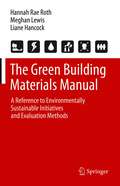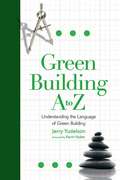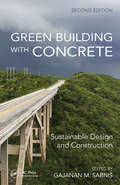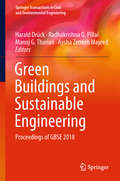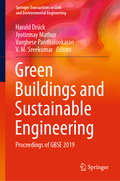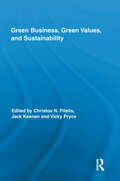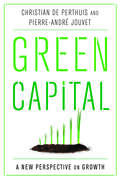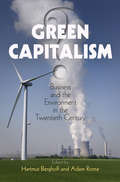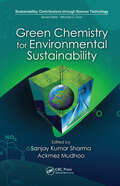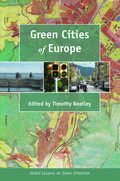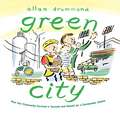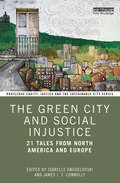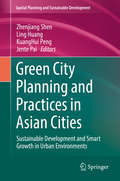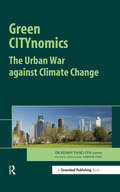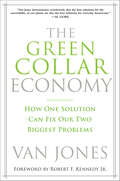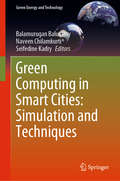- Table View
- List View
The Green Building Materials Manual: A Reference to Environmentally Sustainable Initiatives and Evaluation Methods
by Hannah Rae Roth Meghan Lewis Liane HancockEvaluating building materials for environmental sustainability is a complex prospect. How do governmental agencies and the design industry actually measure sustainable initiatives and environmental impacts? This book breaks down the technical vocabulary and principles that define environmentally sustainable choices across interior and exterior architectural products to help the reader understand: Material ingredient selectionEnergy and water useEmissions, including greenhouse gasesHuman health and toxicitySocial accountability assessment This guide explains the structure of green certifications, standards and ecolabels, life cycle assessment, environmental regulations, and more. It presents a historic timeline for context and a snapshot of current trends and future objectives. It is a comprehensive reference for interior designers, architects, building owners, contractors, and students enrolled in interior design and architecture.
Green Building Products
by Mark Piepkorn Alex WilsonInterest in sustainable, green building practices is greater than ever. Whether concerned about allergies, energy costs, old-growth forests, or durability and long-term value, homeowners and builders are looking for ways to ensure that their homes are healthy, safe, beautiful, and efficient.In these pages are descriptions and manufacturer contact information for more than 1,400 environmentally preferable products and materials. All phases of residential construction, from sitework to flooring to renewable energy, are covered. Products are grouped by function, and each chapter begins with a discussion of key environmental considerations and what to look for in a green product. Over 40 percent revised, this updated edition includes over 120 new products. Categories of products include: Sitework and landscaping Outdoor structures Decking Foundations, footers, and slabs Structural systems and components Sheathing Exterior finish and trim Roofing Doors and windows Insulation Flooring and floor coverings Interior finish and trim Caulks and adhesives Paints and coatings Mechanical systems/HVAC Plumbing, electrical, and lighting Appliances Furniture and furnishings Renewable energy Distributors and retailers An index of products and manufacturers makes for easy navigation. There is no more comprehensive resource for both the engaged homeowner and those who design and build homes.Editor Alex Wilson is president of BuildingGreen, an authoritative source for information on environmentally responsible design and construction, which also publishes Environmental Building News.Co-editor Mark Piepkorn has extensive experience with natural and traditional building methods.
Green Building & Remodeling For Dummies
by Eric Corey FreedWant to build responsibly, reduce waste, and help preserve the environment? Green Building & Remodeling For Dummies is your friendly, step-by-step guide to every facet of this Earth-friendly method of construction. Building a home--even a green home--uses plenty of resources and energy. This practical, hands-on book shows you how to build or remodel conscientiously, whether your dream home is a simple remodel or a brand-new multimillion-dollar mansion.You'll start by identifying green materials and sizing up potential systems and construction sites. You'll weigh the pros and cons of popular green building methods and identify opportunities for saving money in the long run. Need to find some green professionals to assist you in your venture? We'll help you do that, too. This book will also help you discover how to:Understand the lifecycle of building materialsChoose the right system for your green building projectPut together a green teamWork within your budgetUse green building methods and sustainable systemsSpeed construction and reduce energy use and wasteRefinish old fixtures and materialsBeware of asbestos and lead-paint hazardsAvoid costly mistakesComplete with lists of ten green things to do on every project and ten things you can do right now in your home in order to go green, Green Building & Remodeling For Dummies is your one-stop guide to planning and building the home you've always wanted.
Green Building A to Z
by Jerry YudelsonGreen building is the fastest-growing trend to hit since the Internet, bringing with it an enormous range of new products, systems, and technologies. Green Building A to Z is an informative, technically accurate, and highly visual guide to green building, for both decision-makers and interested citizens. It begins with an introduction to the importance of green buildings and a brief history of the green building movement, outlines the benefits and costs of green buildings, and shows how you can influence the spread of green buildings. The book touches on key issues, such as enhancing water conservation, reducing energy use, and creating a conservation economy. The book examines all aspects of green buildings, including: Architecture 2030 Locally sourced materials Natural ventilation Solar energy Zero-net-energy buildings More than just a reference, this book emphasizes the importance of green buildings and green developments for a sustainable future. It will be an invaluable resource for businesspeople, homeowners, product manufacturers, developers, building industry professionals, and government officials.
Green Building with Concrete: Sustainable Design and Construction, Second Edition
by Ian MuehlenhausIllustrates the Global Relevance of SustainabilityApplicable to roads, bridges, and other elements of the infrastructure, Green Building with Concrete: Sustainable Design and Construction, Second Edition provides an overview of all available information on the role of concrete in green building. A handbook offering viewpoints from worldwide experts
Green Buildings and Renewable Energy: Med Green Forum 2019 - Part of World Renewable Energy Congress and Network (Innovative Renewable Energy)
by Ali SayighThis book highlights selected papers presented during the bi-annual World Renewable Energy Network’s 2019 Med Green Forum. This international forum highlights the importance of growing renewable energy applications in two main sectors: Electricity Generation and Sustainable Building. The papers highlight the most current research and technological breakthroughs illustrating the viability of using renewable energy to satisfy energy needs. Coverage includes a broad range of renewable energy technologies and applications in all sectors – electricity production, heating and cooling, agricultural applications, water desalination, industrial applications, and transport. Presents leading-edge research in green building, sustainable architecture, and renewable energy;Covers a broad range of renewable energy technologies and applications in all sectors;Contains case studies and examples to enhance practical application of the technologies presented.
Green Buildings and Sustainable Engineering: Proceedings of GBSE 2018 (Springer Transactions in Civil and Environmental Engineering)
by Harald Drück Radhakrishna G. Pillai Manoj G Tharian Aysha Zeneeb MajeedThis book comprises the proceedings of the International Conference on Green Buildings and Sustainable Engineering (GBSE 2018), which focused on the theme “Transforming our Built Environment through Innovation and Integration towards a Smart and Sustainable Future”. The papers included address all aspects of green buildings and sustainability practices in civil engineering, and offer a valuable reference resource for researchers, practitioners, and policy makers.
Green Buildings and Sustainable Engineering: Proceedings of GBSE 2019 (Springer Transactions in Civil and Environmental Engineering)
by Jyotirmay Mathur Harald Drück Varghese Panthalookaran V. M. SreekumarThis book comprises the proceedings of the International Conference on Green Buildings and Sustainable Engineering (GBSE 2019), which focused on the theme “Ecotechnological and Digital Solutions for Smart Cities”. The papers included address all aspects of green buildings and sustainability practices in civil engineering, and focus on ways and means of reducing pollution and degradation of the environment through efficient usage of energy and water. The book will prove a valuable reference resource for researchers, practitioners, and policy makers.
Green Buildings Pay: Design, Productivity and Ecology
by Brian W. Edwards Emanuele NaboniThis third edition of Green Buildings Pay presents new evidence and new arguments concerning the institutional and business case that can be made for green design. The green argument has moved a long way forward since the previous edition, and this fully updated book addresses the key issues faced by architect, engineer and client today. Green Buildings Pay: Design, Productivity and Ecology examines, through a range of detailed case studies, how different approaches to green design can produce more sustainable patterns of development. These cases are examined from three main perspectives: that of the architect, the client and the user. Completely revised with all new chapters, cases, sections and introductory material the third edition presents: over 20 new researched case studies drawn from the UK, Europe and the USA, written in collaboration with the architects, engineers, clients and user groups examples of office and educational buildings of high sustainable and high architectural quality an exploration of the architectural innovations that have been driven by environmental thinking, such as the new approaches to the design of building facades, roofs, and atria cases which demonstrate current practice in the area of energy/eco-retrofits of existing buildings documentation of the benefit impact assessment schemes such as LEED and BREEAM have had upon client expectations and on design approaches over the past decade beautiful full color illustrations throughout. In the fast evolving arena of green building, the book shows how architects are reshaping their practices to deal with ever more demanding energy standards and better informed users and corporate clients.
The Green Bundle: Pairing the Market with the Planet
by Magali A. Delmas David ColganThe market for green products has expanded rapidly over the last decade, but most consumers need something more than eco-benefits to motivate their purchases. Magali A. Delmas and David Colgan argue that many green products now offer the total package—a "green bundle" that checks the environmental box, but also offers improved performance, health benefits, savings, and status. To help consumers cut through the noise and make their best decisions, we need new strategies. The Green Bundle offers some of the best and most effective communication techniques for pushing consumers in the right direction. Framing product benefits to motivate behavior is the key. Combining insights from sustainable business and behavioral economics, Delmas and Colgan show managers how to lead buyers from information to action. If you are looking to win over the convenient consumer or understand how companies can create the next tipping point in green consumption, this is the research-based, practical guide for you.
Green Business, Green Values, and Sustainability (Routledge Studies in Corporate Governance)
by Vicky Pryce Christos N. Pitelis Jack KeenanToday greenness is goodness; non-greenness is not an option. It is therefore critical to advance thinking on why and how business, consumers and policy makers can contribute to the goal of sustainable global wealth creation. This volume analyzes the strategic sustainability issues confronting contemporary business, and explores the transformation in values, strategies, and practices needed by modern businesses to attain sustainable business. It is is developed from a Global Business Symposium organized by the Centre for International Business and Management (CIBAM) at Cambridge University in February 2009, which brought together leading academics, scientists and engineers, government leaders, and business executives to consider the transformation in business values and strategies implicit in sustainability. Green Business, Green Values and Sustainability offers a concise and definitive book on the green transformation of business in major sectors including government, finance, energy, and retail. Different solutions to sustainability are explored including ethical approaches, alternative environmental strategies, corporate responsibility, and carbon reductions.
Green Capital: A New Perspective on Growth
by Christian de Perthuis Pierre-André JouvetMany believe economic growth is incompatible with ecological preservation. Green Capital challenges this argument by shifting our focus away from the scarcity of raw materials and toward the deterioration of the great natural regulatory functions (such as the climate system, the water cycle, and biodiversity). Although we can find substitutes for scarce natural resources, we cannot replace a natural regulatory system, which is incredibly complex. It is therefore critical that we introduce a new price into the economy that measures the costs of damage to these regulatory functions. This change in perspective justifies such innovations as the carbon tax, which addresses not the scarcity of carbon but the inability of the atmosphere to absorb large amounts of carbon without upsetting the climate system. Brokering a sustainable peace between ecology and the economy, Green Capital describes a range of valuation schemes and their contribution to the goals of green capitalism, proposing a new approach to natural resources that benefits both businesses and the environment.
Green Capital
by Michael Westlake Pierre-André Jouvet Christian De PerthuisChallenging the certainty that ecological preservation is incompatible with economic growth, Green Capital shifts the focus from the scarcity of raw materials to the deterioration of the great natural regulatory functions (such as the climate system, the water cycle, and biodiversity). While we can find substitutes for scarce natural resources, we cannot replace a natural regulatory system, which is incredibly complex. It is then essential to introduce a new price into the economy that measures the costs of damage to these regulatory functions. This shift in perspective justifies such innovations as the carbon tax, which addresses not the scarcity of carbon but the inability of the atmosphere to absorb large amounts of carbon without upsetting the climate system. Brokering a sustainable peace between ecology and the economy, Green Capital describes a range of valuation schemes and their contribution to the goals of green capitalism, proposing a new, practical approach to natural resources that benefits both businesses and the environment.
Green Capitalism?: Business and the Environment in the Twentieth Century (Hagley Perspectives on Business and Culture)
by Hartmut Berghoff Adam RomeAt a time when the human impact on the environment is more devastating than ever, business initiatives frame the quest to "green" capitalism as the key to humanity's long-term survival. Indeed, even before the rise of the environmental movement in the 1970s, businesses sometimes had reasons to protect parts of nature, limit their production of wastes, and support broader environmental reforms. In the last thirty years, especially, many businesses have worked hard to reduce their direct and indirect environmental footprint. But are these efforts exceptional, or can capitalism truly be environmentally conscious?Green Capitalism? offers a critical, historically informed perspective on building a more sustainable economy. Written by scholars of business history and environmental history, the essays in this volume consider the nature of capitalism through historical overviews of twentieth-century businesses and a wide range of focused case studies. Beginning early in the century, contributors explore the response of business leaders to environmental challenges in an era long before the formation of the modern regulatory state. Moving on to midcentury environmental initiatives, scholars analyze failed business efforts to green products and packaging—such as the infamous six-pack ring—in the 1960s and 1970s. The last section contains case studies of businesses that successfully managed greening initiatives, from the first effort by an electric utility to promote conservation, to the environmental overhaul of a Swedish mining company, to the problem of household waste in pre-1990 West Germany. Ranging in geographic scope from Europe to the United States, Green Capitalism? raises questions about capitalism in different historical, sociocultural, and political contexts.Contributors: Hartmut Berghoff, Ann-Kristin Bergquist, Brian C. Black, William D. Bryan, Julie Cohn, Leif Fredrickson, Hugh S. Gorman, Geoffrey Jones, David Kinkela, Roman Köster, Joseph A. Pratt, Adam Rome, Christine Meisner Rosen.
Green Chemistry and Sustainability in Pulp and Paper Industry
by Pratima BajpaiThis book features in-depth and thorough coverage of Minimum Impact Mill Technologies which can meet the environmental challenges of the pulp and paper industry and also discusses Mills and Fiberlines that encompass "State-of-the-Art" technology and management practices. The minimum impact mill does not mean "zero effluent", nor is it exclusive to one bleaching concept. It is a much bigger concept which means that significant progress must be made in the following areas: Water Management, Internal Chemical Management, Energy Management, Control and Discharge of Non-Process Elements and Removal of Hazardous Pollutants. At the moment, there is no bleached kraft pulp mill operating with zero effluent. With the rise in environmental awareness due to the lobbying by environmental organizations and with increased government regulation there is now a trend towards sustainability in the pulp and paper industry. Sustainable pulp and paper manufacturing requires a holistic view of the manufacturing process. During the last decade, there have been revolutionary technical developments in pulping, bleaching and chemical recovery technology. These developments have made it possible to further reduce loads in effluents and airborne emissions. Thus, there has been a strong progress towards minimum impact mills in the pulp and paper industry. The minimum-impact mill is a holistic manufacturing concept that encompasses environmental management systems, compliance with environmental laws and regulations and manufacturing technologies.
Green Chemistry for Environmental Sustainability (Sustainability: Contributions through Science and Technology)
by Sanjay KumarSharma Ackmez MudhooWhen the Nobel Prize Committee recognized the importance of green chemistry with its 2005 Nobel Prize for Chemistry, this relatively new science came into its own. Although no concerted agreement has been reached yet about the exact content and limits of this interdisciplinary discipline, there seems to be increasing interest in environmental topic
Green Chic: Saving the Earth in Style
by Christie MathesonWant to go green without giving up great style? Not sure how to make changes--or why they matter? Welcome to the world of GREEN CHIC. Being green--thoughtfully, consciously green--makes a real difference in the fight against global warming. But did you know that it's also hip, classic, and stylish? --Look gorgeous --Love your wardrobe --Feel amazing --Travel in style --Create a home that's an oasis --Host fun parties --Eat incredible food and drink phenomenal wine --Feel more connected to your friends, family, and nature. (And did we mention that green women don't get fat?) Offering up dozens of author-tested, earth-friendly ideas, lifestyle writer Christie Matheson reveals that being chic and saving the planet aren't mutually exclusive. Can living a chic green lifestyle TRULY makes a difference? You bet your organic sheets it can. It's a calmer, more relaxed, more fabulous path that's about quality and quality of life. Embrace the fabulousness of green living. Being green isn't a fad--it's timelessly chic.
Green Cities of Europe: Global Lessons on Green Urbanism
by Timothy Beatley Maria Jaakkola Wulf Daseking Michaela Bruel Lucie Laurian Dale MedearisIn the absence of federal leadership, states and localities are stepping forward to address critical problems like climate change, urban sprawl, and polluted water and air. Making a city fundamentally sustainable is a daunting task, but fortunately, there are dynamic, innovative models outside U.S. borders. Green Cities of Europe draws on the world's best examples of sustainability to show how other cities can become greener and more livable. Timothy Beatley has brought together leading experts from Paris, Freiburg, Copenhagen, Helsinki, Heidelberg, Venice, Vitoria-Gasteiz, and London to illustrate groundbreaking practices in sustainable urban planning and design. These cities are developing strong urban cores, building pedestrian and bicycle infrastructure, and improving public transit. They are incorporating ecological design and planning concepts, from solar energy to natural drainage and community gardens. And they are changing the way government works, instituting municipal "green audits" and reforming economic incentives to encourage sustainability. Whatever their specific tactics, these communities prove that a holistic approach is needed to solve environmental problems and make cities sustainable. Beatley and these esteemed contributors offer vital lessons to the domestic planning community about not only what European cities are doing to achieve that vision, but precisely how they are doing it. The result is an indispensable guide to greening American cities. Contributors include: Lucie Laurian (Paris) Dale Medearis and Wulf Daseking (Freiburg) Michaela Brüel (Copenhagen) Maria Jaakkola (Helsinki) Marta Moretti (Venice) Luis Andrés Orive and Rebeca Dios Lema (Vitoria-Gasteiz) Camilla Ween (London)
Green City: How One Community Survived a Tornado and Rebuilt for a Sustainable Future
by Allan DrummondIn 2007, a tornado destroyed Greensburg, Kansas, and the residents were at a loss as to what to do next--they didn't want to rebuild if their small town would just be destroyed in another storm. So they decided they wouldn't just rebuild the same old thing; this time, they would build a town that could not only survive another storm, but one that was built in an environmentally sustainable way. Told from the point of view of a child whose family rebuilt after the storm, this companion to Energy Island is the inspiring story of the difference one community can make--and it includes plenty of rebuilding scenes and details for construction lovers, too!
The Green City and Social Injustice: 21 Tales from North America and Europe (Routledge Equity, Justice and the Sustainable City series)
by Isabelle Anguelovski and James J. T. ConnollyThe Green City and Social Injustice examines the recent urban environmental trajectory of 21 cities in Europe and North America over a 20-year period. It analyses the circumstances under which greening interventions can create a new set of inequalities for socially vulnerable residents while also failing to eliminate other environmental risks and impacts. Based on fieldwork in ten countries and on the analysis of core planning, policy and activist documents and data, the book offers a critical view of the growing green planning orthodoxy in the Global North. It highlights the entanglements of this tenet with neoliberal municipal policies including budget cuts for community initiatives, long-term green spaces and housing for the most fragile residents; and the focus on large-scale urban redevelopment and high-end real estate investment. It also discusses hopeful experiences from cities where urban greening has long been accompanied by social equity policies or managed by community groups organizing around environmental justice goals and strategies. The book examines how displacement and gentrification in the context of greening are not only physical but also socio-cultural, creating new forms of social erasure and trauma for vulnerable residents. Its breadth and diversity allow students, scholars and researchers to debunk the often-depoliticized branding and selling of green cities and reinsert core equity and justice issues into green city planning—a much-needed perspective. Building from this critical view, the book also shows how cities that prioritize equity in green access, in secure housing and in bold social policies can achieve both environmental and social gains for all.
Green City Planning and Practices in Asian Cities: Sustainable Development And Smart Growth In Urban Environments (Strategies for Sustainability)
by Zhenjiang Shen Ling Huang KuangHui Peng Jente PaiUrban planners across the world are faced with sustainable development issues in their work, especially when they are tasked with creating green cities or where sustainable and smart growth in urban settings are set as primary goals. This book introduces green city planning and practices from the three dimensions of green-building innovation, community development and smart city strategies, and argues that effective implementation of green city planning are a necessary pre-condition for reaching sustainable urban development. A range of authors representing a broad disciplinary spectrum bring together the different standards of green building methods and urban design techniques and clearly sketch the roles of both spatial designers and urban researchers in the implementation of green city planning at regional, community and single-building level in order to arrive at an integrated approach across different scales.
Green CITYnomics: The Urban War against Climate Change
by Kenny Tang Lorraine TangToday, more than half of the world's population are living in cities that are now contributing 80% of global greenhouse gas emissions. They cover less than 3% of the earth's surface. And urbanization continues apace. With such a massive carbon footprint, it is vital that cities are part of the solution. Despite this, scarcely any consideration has been given to the potential impact of climate change on urban dwellers, especially in the developing countries and burgeoning megacities of Africa, Asia and Latin America, where a wide variety of environmental and development challenges are likely to further exacerbate their vulnerability to climatic effects. Green CITYnomics presents a rich set of contributions by a highly diverse group of 45 of the world's leading urban experts on climate change. In particular, it illustrates the desire some cities are already demonstrating in engaging in this war. Standing still is not an option. Budgets have to be fought for; minds have to be won over; old, untenable and unsustainable ideas and solutions must be challenged; green and sustainable solutions must be given the chance to develop and to prove themselves. Each of the cities and urban centres discussed – from Hong Kong to Dresden; from Mexico City to Qatar – are, in their own ways, heroes and examples to us all. This book provides a compelling manifesto for the world's cities in their "Urban War against Climate Change". It is essential reading for climate scientists, national and local policy-makers and scholars worldwide.
Green Classroom Book: From Recycling to Conversation, All You Need to Create an Eco-Friendly Learning Environment (The Everything®)
by Tessa HillThis book is the essential guide for teaching children about nature and environmental protection. This guide shows teachers how to incorporate “green” concepts into everyday lessons, activities, and field trips. Also included are ways to send the lesson home, with clear steps for teaching children how to make saving the earth a part of their daily lives. Features information on:The best ways to address issues like global warming and the disappearing rainforests Sustainable school suppliesEco-friendly fundraisingInspiring field trip ideas (from the local farm to the local landfill!)Innovative ways to reduce, reuse, and recycleTeachers, students, administrators, and parents will learn to take green practices from the classroom to the larger world outside. By using teacher-tested activities and the inspiring stories of real kids, this book will motivate teachers and their students to turn education into action.
The Green Collar Economy: How One Solution Can Fix Our Two Biggest Problems
by Van Jones“Steadily—by redefining green—Jones is making sure that our planet and our people will not just survive but also thrive in a clean-energy economy.”—Leonardo DiCaprioA New York Times bestseller, The Green Collar Economy by award-winning human rights activist and environmental leader Van Jones delivers a much-needed economic and environmental solution to today’s two most critical problems. With a revised introduction and new afterword by the author—a man who counsels President Barack Obama on environmental policy—The Green Collar Economy and Jones have been highly praised by a multitude of leaders and legislators, including Al Gore, Senator Tom Daschle, and Speaker of the House Nancy Pelosi. Van Jones was named one of “The World’s 100 Most Influential People of 2009”by Time magazine, and with The Green Collar Economy he offers a wise, necessary, and eminently achievable plan for saving the earth and rescuing working class Americans.
Green Computing in Smart Cities: Simulation and Techniques (Green Energy and Technology)
by Balamurugan Balusamy Naveen Chilamkurti Seifedine KadryThe book collects the latest research and thinking from international experts on green computing and the smart city. The financial and environmental costs of energy are a concern in smart cities due to the high usage of computing, technology, security, IoT, communications, traffic, and other technologies. This book tackles this problem with a focus on computing, reporting on various approaches being taken worldwide, illustrated by several international case studies demonstrating these approaches. Researchers use this book as an up-to-date reference and engineers use it as a guide for the design and implementation of real solutions.
